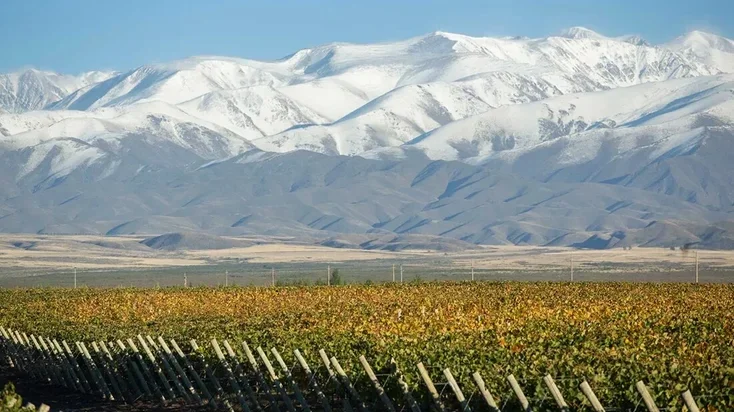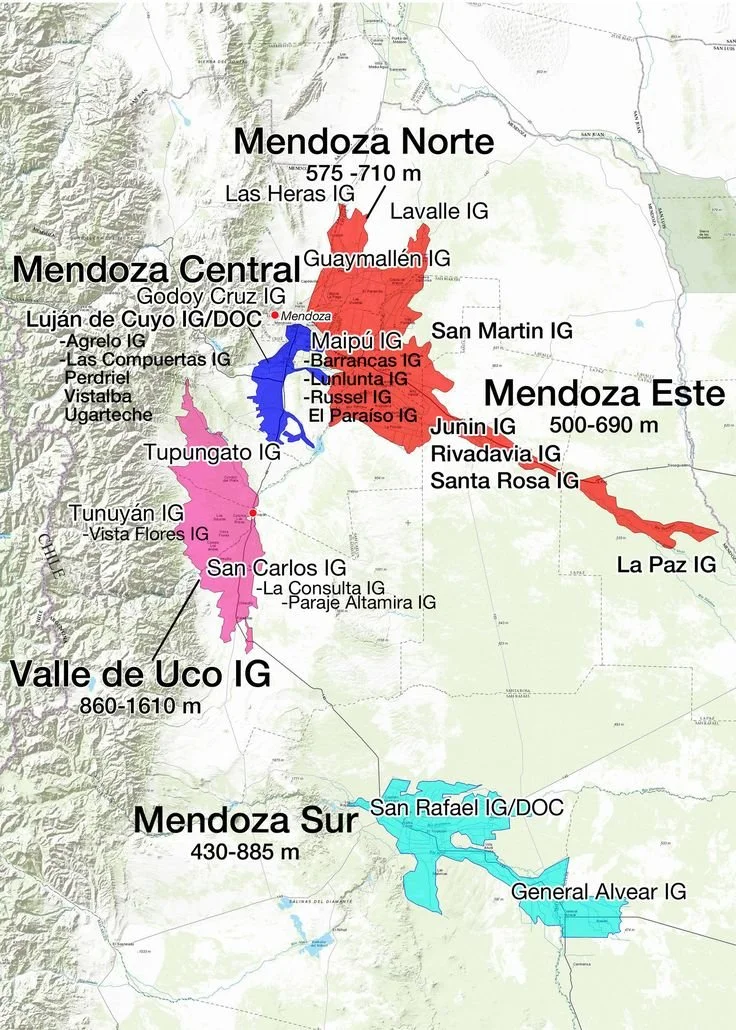Argentina > Mendoza > Cheval des Andes
Sustainable, Organic Practices
The Las Compuertas Vineyard, Lujan de Cuyo, Argentina
“[A]n age-worthy and sophisticated red blend which evolves beautifully in the cellar, showing the fine wine potential of Malbec blends. A deserving icon of Mendoza.”
Mendoza and the formation of Argentina
Mendoza is a vast province in west-central Argentina covering some 51,800 square miles, sweeping upward from the broad plateau of the pampas up to the crest of the Andes Mountains. The highest point in the Americas is Mount Aconcagua at the crest of the Andes on the Chile/Mendoza (Argentina) border, at 22,837ft. Together with the provinces of San Juan to its north and La Rioja to the north of that, these three provinces make up the Cuyo, the desert country of west-central Argentina, source of some 95% of Argentina’s wine production.
Human habitation dates back some 12,000 years, and by 300 BC there were settled hunter/farmer groups in the area. By 1500 AD, the region was under the sway of the Inca Empire, which itself collapsed under the Spanish Conquest of 1532 - 1572.
The first Spanish settlers in the future province of Mendoza crossed the Andes from Peru in the 1550’s and in 1561 Pedro del Castillo established the city of Mendoza in what was then the eastern flank of the Captaincy General of Chile. In 1776 the region was transferred to the new Viceroyalty of the Rio de la Plata, and by 1816 Argentina had declaraed its independence from Spain. The War of Independence however would last until 1825.
A series of civil wars lasting until about 1880, an earthquake that levelled the city of Mendoza in 1861 paved the way for the arrival of the railroads in the 1880’s, the rebuilding of the city, and a massive influx of immigrants largely from Italy and Spain into the early 20th Century. This established Mendoza Province as a key agricultural and viticultural resource for Argentina, with ready access by rail to the Capital at Rio de Janeiro.
Lujan de Cuyo La consulta & las compuertas
The climate of Mendoza is continental, sunny and dry in the entire territory of the province, with warm summers and relatively cold winters. The annual precipitation lies between 150 and 350mm, and with altitudes of 2000-3600ft, the area experiences high diurnal temperature swings.
Mt Aconcagua. Photo credit
Viticulture is hugely important to the province, which produces some 120 million cases of wine annually from about 150,000 acres of vines.
The majority of the vineyards are found in the Maipú and Luján departments of Mendoza province. In 1993, the Mendoza sub-region of Luján de Cuyo was the first controlled appellation established in Mendoza. Other important sub-regions include the Uco Valley and the Tupungato zone to the south. The soil of the region is gravelly, sandy and alluvial on top of clay substructures. These low-fertility soils poor in organic matter stress the vines and encourage superb-quality fruit with small, perfectly ripened berries.
Mendoza’s viticulture is unique in using an ancient Inca technique of flood irrigation as adapted by the Spanish in the 16th and 17th Centuries. Water is channelled from glacial melt into a series of reservoirs and then channelled down onto the gravel flatlands. The dry climate, steady winds and deep flood irrigation prevent both most fungal infections, and uniquely in the world, the establishment of phylloxera. As a result, most of Mendoza’s vines are, even today, ungrafted.
Mendoza: Lujan & the Valle de Uco
Lujan de Cuyo is a small appellation located on the banks of the Mendoza River which includes five sub-zones: Vistalba, Pedriel, Agrelo, Ugarteche, and Las Compuertas.
Las Compuertas (“The Floodgates”) in turn is located right where the Mendoza River exits the Andes as it flows out from the manmade Lake Potrerillos, and has some of the regions highest elevations, coolest climates and oldest vines, many well over 100 years old. it’s a small region of some 4400 acres, of which about 1050 are planted to vines.
La Consulta, named for a meeting in the eponymous village during the Argentine Wars of Independence, is a bit further to the south, in the San Carlos district of the valley of the Uco River. This is in the southern (upstream, headwater) end of the Uco Valley, the valley of the Tunuyan River. The total area of the IG is 4400 acres, of which 1050 acres are planted to vine. Located at an altitude of 1,100 meters (3,600 feet), La Consulta is characterized by a greater diurnal temperature variation than Las Compuertas. Its alluvial soils are composed of: sand (60%), clay (10%) and limestone (30%).
“Sustainability at Cheval des Andes
No use of pestidices or herbicides
*
Cover crops between the rows
*
Flower plantings to attract pollinators and predator insects to manage pests
*
Natural animal fertilizers
*
On-site herds of sheep, horses, cows, llamas & alpacas
*
Organic vegetable gardens
*
Wool from their own herds used to provide warm gear for vineyard workers
*”
The Cuyo- La Rioja (violet), San Juan (blue) & Mendoza green)
cheval des andes
“Cheval des Andes is more than just a wine—it’s a testament to the art of winemaking, combining innovation with tradition. ”
Cheval des Andes is a joint venture of Chateau Cheval Blanc, the finest estate in Bordeaux’ Saint Emilion region, and Terrazas de los Andes, one of the pioneers of fine Malbec winemaking in Lujan de Cuyo, and holder of about a dozen of Lujan’s finest vineyards.
When Pierre Lurton, Maitre de Chai of Chateau Cheval Blanc discovered the stunning Malbec vineyard of Las Compuertas, planted in Mendoza in 1929, he was immediately captivated, declaring, “This will be a journey to the roots of Bordeaux.” He wanted to bring yesterday’s Bordeaux wines back to life, reconnecting Château Cheval Blanc with the history of Saint-Emilion. Working with the team at Terrazas de Los Andes, they crafted on of Argentina’s most stunning wines.
Cheval des Andes has 50 hectares (123 acres) of vineyards in two sites- Las Compuertas in Lujan, planted in 1929 at 3500 ft on rocky loamy sand and gravel, and La Consulta further to the south in the Valle de Uco, planted in 1945 at 3600 ft on sandier soil.
The result is an age-worthy and sophisticated red blend which evolves beautifully in the cellar, showing the fine wine potential of Malbec blends. Cheval des Andes is typically about 48% Malbec, 48% Cabernet Sauvignon and a few percent Petit Verdot.
The Wines
Cheval des Andes makes a single wine- a perfect marriage of the savoir-faire of Cheval Blanc with the deep knowledge and perfect sites of Terrazas de Los Andes. Each vintage is a unique expression of this epitome of Argentine, Malbec-based winemaking. Notes from the winemaker:
Cheval des Andes 2019: 50% Malbec, 50% Cabernet Sauvignon. “At first glance, the wine is brilliant, with an intense ruby red color with garnet hues. The nose is filled with intense notes of fresh red fruits such as cherries, currants and plums with touches of herbs and flowers that remind us of violets and lavender. Little by little, subtle spicy notes with hints of vanilla, cedar and liquorice develop from the elegant integration with the oak. Refreshingly smooth on the palate, with great personality, elegant tannins and a sharp and balanced acidity.”
Cheval des Andes 2020: 49% Malbec, 49% Cabernet Sauvignon, 2% Petit Verdot. “Intense, deep and shiny, velvety red colour. Generous and expressive on the nose, with ripe red fruits such as cherries, plums and cassis combined with hints of spices, black pepper and violets. On the palate, starts out sumptuously rich and full-bodied. The powerful and refined tannins contribute to the structure of this wine. The finish marks a return to red and stony fruits aromas with spicy overtones.”
Cheval des Andes 2021: 49% Malbec, 48% Cabernet Sauvignon, 3% Petit Verdot. “In the glass it presents a delicate and brilliant ruby red tone with garnet glints that add depth to the sight. On the nose, this wine offers a fine complexity. Initially, a fragrant blend of spices captivates the senses, gradually evolving into a rich and varied aromatic palette. Here, floral notes of jasmine, honeysuckle and violets intertwine with the freshness of red and forest fruits. Currants, raspberries, strawberries and blueberries emerge as protagonists, granting this bouquet of incomparable freshness. On the palate, this wine is distinguished by its elegance and delicacy, its acidity and freshness emerge as two of its most outstanding attributes. Its unique texture, characterized by silky tannins typical of a fine integration of wood, merge with a lingering finish that faithfully reflects the richness of its initial aromas.”





